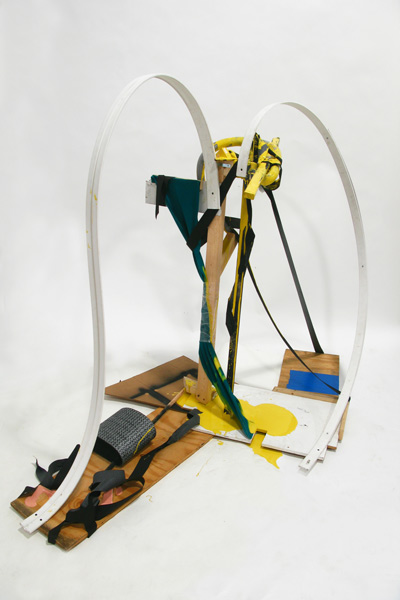
A German pioneer comes back to life in a new group show
There is special show up at Fredric Snitzer‘s gallery, a quietly intriguing, group show with an equally intriguing origin. The 13 works from local and international artists are inspired by Kurt Schwitters, the German painter, sculptor and designer associated with Expressionism and Dadaism, who worked during the war-torn years in the Europe of the 20th century. He might be best remembered for his collage and assemblages, which is where he derived a term for his productions: Merz (loosely, a combination of varied materials for artistic purposes). Hence the title of this exhibition, “Merzbau — Now.”
In very different styles and looks, the modern Merz crafters have come up with some fascinating sculptures, with collage as a dominant theme. In the middle of the gallery, the Norwegian-born Ida Ekblad (who now lives in Berlin) set up a grouping of sculptures made from, for instance, “National Geographic” magazines and other found materials.
In a direct nod to the lineage in this show, German avant-garde artist and performer John Bock has a stand-out (and stand-alone) piece, “Die Schritte in. Zwolf Uhr Mittags,” which includes a Bock book and other, well, things. Another sculpture/installation that will catch your eye: the black, collapsed piece against a wall. It’s from Christian Holstad. It looks like a weird shopping cart that has been deflated (is has deflated tires, as well) but is called “Black Friday (in negative) or Medusa.” The disparate materials here: tubing, vinyl and reflective fabric.
As for the locals, both Jose Bedia’s piece that takes over the front wall and part of the floor will be instantly recognizable, as will the collage painting from Michael Vasquez. And don’t overlook the tiny found object from Bert Rodriguez. Maria Martinez-Canas’ canvas is the opposite in scale, and one of the sculptures from Mauricio Gonzalez gets a well-deserved space to itself.
Some of the output from Schwitters didn’t survive the incredible destruction of World War II, including the “Merzbau” building/assemblage itself. So there is no better way to keep the intellectual and creative foundation of it alive than by putting together this “collage” of talented artists, whose works are their own but which are grounded in a significant past that shouldn’t be left to dust. Miami (and most places) can use all the historical tutoring it can get.
“Merzbau — Now” at the Fredric Snitzer Gallery, 2247 N.W. First Place, Miami; 305-448-8976; www.snitzer.com.
Recent Content
-
Artsarticle ·
-
Artsarticle ·
-
Artsarticle ·
